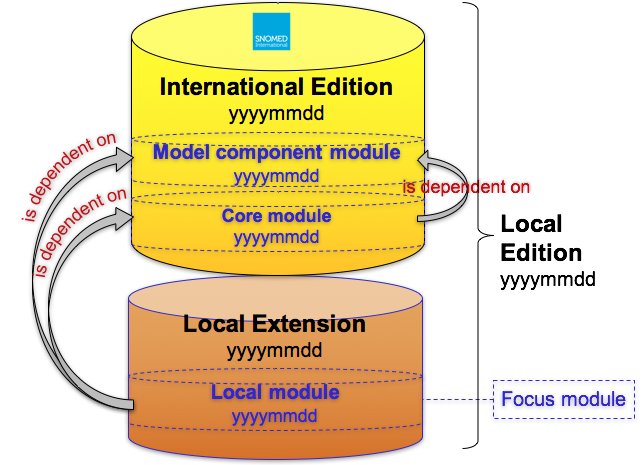With the exception of the International Edition, an edition is the combination of an extension plus additional modules which are depended on. This will always include the | SNOMED CT core module| and the | SNOMED CT model component module| , but may also include other modules. In Extensions, we established that an extension is a set of modules which are created and maintained by a single organization. An edition is also set of modules, but it is a set which includes a focus module plus the modules on which the focus module depends. It can therefore be packaged and used as a standalone terminology solution within a healthcare environment. This explains why many organizations will chose to publish an edition and not an extension. Note that national and local editions are comprised of modules which are maintained by separate organizations including SNOMED International.
below illustrates the composition of a generic edition based on an extension, its included module, and the stated dependencies.
The local module, which is also the focus module of this edition, is dependent on both the
|
SNOMED CT core module|
and the
|
SNOMED CT model component module|
, which means the content in the local module (components and/or reference sets) references components in both of these modules. The version-specific dependencies have been stated in a Module Dependency Reference Set.
Although components and reference sets are not shown in this diagram, recall that they are part of a single module. This edition therefore includes the components and refsets that part of the local module, the | SNOMED CT core module| , and the | SNOMED CT model component module| .
Versioned Edition
Many use cases have a requirement to reference a date specific version of an edition to ensure the inclusion or exclusion of specific content. This is where the term substrate comes from. A substrate is essentially a versioned edition of SNOMED CT.
Use cases for referring to a versioned edition include SNOMED CT bindings in information models, defining SNOMED CT value sets in healthcare standards, and referencing SNOMED CT content in analytics and decision support artifacts. In all of these cases, the version of the SNOMED CT content referenced is of significance due to changes in terminology over time, and the fact that all SNOMED CT content belongs to a specific module.
SNOMED International and most NRCs publish biannual versions, on a predetermined cycle. Other organizations may chose to adhere to their own release cycle.
Identification
Users of SNOMED CT may refer to versioned editions using the URI Standard. More specifically, using the URI structure for a versioned edition.
The table below includes some examples of versioned editions of SNOMED CT. Note that the included modules are listed in the last column, beginning with the least dependent module. (Focus module in red.)
| Edition | Focus module | URI | Included modules |
|---|---|---|---|
International Edition, 20170731 | Metadata + Core | ||
| International Edition, 20170731 (with ICD-10 maps) | http://snomed.info/sct/449080006/version/20170731 | Metadata + Core + ICD-10 maps | |
| US Edition, 20170901 | http://snomed.info/sct/731000124108/version/20170901 | Metadata + Core + NLM maintained module | |
US Edition, 20170901 (with ICD-10-CM maps) | http://snomed.info/sct/5991000124107/version/20170901 | Metadata + Core + NLM maintained module + ICD-10-CM maps |
The table also shows that a release package may include more than one valid URI. For example, there may be cases with it is useful to refer to the International Edition with or without the ICD-10 maps. In each case the focus module is different. For more information on release packages, please refer to 4.5 Release Packages or 5.6.1.2 Packaging and File Naming.
Most Dependent Module
As the definiton of an editon is based on a focus module, it logically follows that editions must have a most dependent module. This is because the dependencies are unidirectional and stated upwards towards the less dependent modules, ultimately arriving at the
|
SNOMED CT model component module|
. In cases where an edition has two equally dependent sibling modules, it is necessary to define an additional module at a lower level, just so one edition can be defined which includes both of the sibling modules. Note that in these cases, the least dependent module need not have any components which are part of this module, it has strictly been added to provide a logical way of grouping all the modules. A practical use case for having two equally dependent sibling modules might be when we have a national extension which provides two additional languages, whose terms are rely on concepts from the International Edition. below provides a theorectical representation of how this would be defined.
In this case, modules A and B are siblings, because they are both dependent on the
|
SNOMED CT core module|
and not one another. As the diagram shows, a most dependent National module has been defined which is dependent on both modules. We can therefore designate this module as the focus module and define an edition which includes modules A and B. Without this most dependent module, it would not be possible to define an edition which includes all modules within the extension.
Feedback

